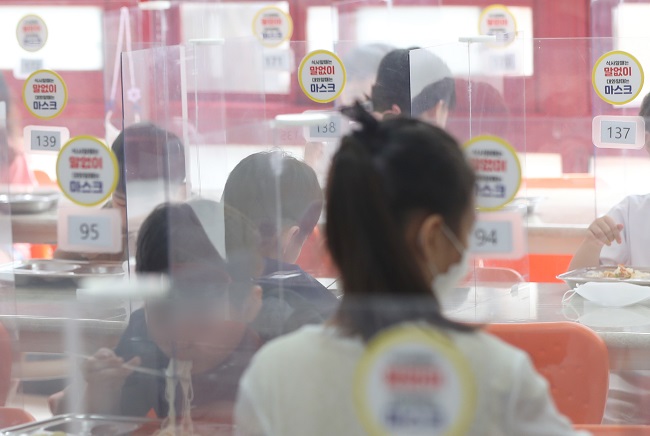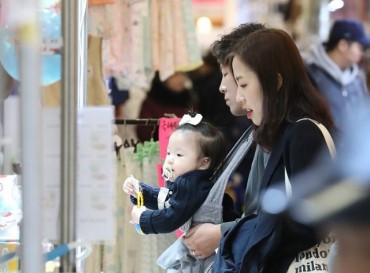
People stand in line to get COVID-19 tests at a screening station in front of Suseo Station in southern Seoul on Sept. 8, 2021. (Yonhap)
SEOUL, Sept. 8 (Korea Bizwire) — South Korea’s daily new coronavirus cases surged to over 2,000 again in a week on Wednesday as authorities step up antivirus efforts and the vaccination drive to curb the pandemic.
The country added 2,050 more COVID-19 cases, including 2,014 local infections, raising the total caseload to 265,423, according to the Korea Disease Control and Prevention Agency (KDCA).
The latest caseload bounced back to over 2,000 in a week.
It is up from 1,597 on Tuesday, 1,375 on Monday and 1,490 on Sunday, when new cases usually remain lower than other weekdays due to less testing over the weekend.
Daily cases have stayed in the four-digits for the last 64 days amid the fast spread of the more transmissible variants nationwide.
The country added four more deaths from COVID-19, raising the death toll to 2,334.
As of 9 p.m. Wednesday, health authorities and local governments reported 1,926 more cases, up 67 from the same time on Tuesday. Daily new cases are counted until midnight and announced the following morning.
Health authorities expressed worries about the virus resurgence in the Seoul metropolitan area, which could spread across the nation when people travel during the fall harvest Chuseok holiday, set for Sept. 20-22.
Among the locally transmitted cases, 77.3 percent were from the greater Seoul area, home to half of the nation’s population.
“The Seoul metropolitan area is seeing a rising number of new cases as well as movement,” Park Hyang, a senior health official, said during a briefing. “They are seen as a very dangerous sign.”
Ahead of the holiday, authorities decided to extend the current distancing measures — Level 4 in the greater Seoul area, which is the highest in the four-tier system, and Level 3 in other regions — for another four weeks through Oct. 3.
Despite the stringent curbs, some restrictions were eased to give leeway to vaccinated people and allow more students to take in-person classes to mitigate the prolonged pandemic’s impact on the local economy.
“The number of new patients have moved up and down since the fourth wave of the pandemic began in July, but we have to take extra caution as new distancing measures are adopted,” Vice Minister of Health and Welfare Kang Do-tae said during a virus response meeting.
“The next four weeks will be critical.”
In response to growing pandemic fatigue and damage faced by small business owners, authorities said they will consider a new COVID-19 response scheme if infections stay at manageable levels after the Chuseok holiday, to help bring life back to normal.

Students separated by translucent partitions eat lunch at an elementary school in Gimhae, 450 kilometers southeast of Seoul, on Sept. 8, 2021. (Yonhap)
Officials said the government may be able to consider gradually relaxing distancing measures as early as November when most people are vaccinated against COVID-19.
A total of 3.13 million people, or 61 percent of the country’s 52 million population, have received their first shots of COVID-19 vaccines, and 18.8 million people, or 36 percent, have been fully vaccinated, the KDCA said.
The second batch of coronavirus vaccines from Romania, including 526,500 doses of Pfizer’s and 450,000 doses of Moderna’s, will arrive in the nation later in the day, authorities said.
The country plans to provide at least one jab to 70 percent of the population by the end of September to create herd immunity in November.
While the vaccination rate among those aged 60 or more is over 80 percent, the corresponding figure for people in their 20s, 30s and 40s remains below 30 percent as they have been receiving jabs since late August.
Of 13.9 million adults aged between 18 and 49, 72.5 percent have booked their jabs as of Wednesday, the KDCA said.
Of the newly confirmed domestic cases, 665 were from Seoul, 691 from the surrounding Gyeonggi Province and 120 from the western port city of Incheon.
Imported cases, which include South Korean nationals, came to 36.
The number of patients with serious symptoms across the country reached 387, up 23 from the previous day.
The total number of people released from quarantine after making full recoveries was 237,286, up 2,061 from a day earlier.
(Yonhap)






